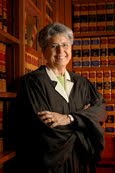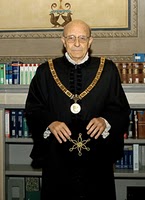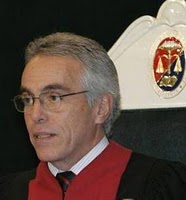I am here in Washington, D.C., at the XVIIIth International Congress of Comparative Law.
The congress is taking place all of this week, presented by the International Academy of Comparative Law and the American Society of Comparative Law, and hosted by three local law schools, American University Washington College of Law, George Washington University Law School, and Georgetown University Law Center. It is a pleasure to be among such a diverse group of jurists, lawyers, and scholars from around the world. The Academy, which is composed of academics and jurists from around the world, organizes every 4 years in different parts of the world an international congress of comparative law. From my understanding, this is the first time that an international congress has been held in the United States.
The conference got off to a great start today with an opening plenary addressing the "Role of Comparative Law in Courts and International Tribunals." The panel was chaired by the Secretary-General of the International Academy of Comparative Law and Director of the Max Planck Institute for Comparative and International Private Law in Hamburg, Dr. Jürgen Basedow. Representing views from both domestic and international courts, as well as a viewpoint from practice, the distinguished panelists discussed the role of both international and comparative law in their own courts:

Judge Rosemary Barkett (right), U.S. Court of Appeals for the Eleventh Circuit (for whom I had the privilege of clerking), began by remarking that to some extent comparing laws has some role in all jurisdictions. She presented a historical perspective from the United States to demonstrate that the practice of considering foreign sources is rooted in the legal history and tradition of the United States, citing to the Declaration of Independence, the U.S. Constitution, and the Federalist papers, as well as to numerous opinions from the U.S. Supreme Court. One of Judge Barkett’s most important points was that, as international and comparative scholars, we need to address the definitional problems in comparative law. For example, many jurisdictions espouse allegiance to the rule of law, but what exactly does rule of law entail?

Justice Sabino Cassese (left), of the Constitutional Court of Italy, next provided three distinct examples of courts looking beyond their own nation’s borders for insights. He emphasized that recourse to comparison by high courts is widespread, and that increasingly supreme courts are acting as comparatists. Justice Cassese emphasized two tasks for comparative lawyers and scholars: one, to examine and evaluate how judges and courts use foreign law; and two, to develop methods and procedures for comparison.
The presentations of Judge Barkett and Justice Cassese were followed by the practitioner’s perspective, Carolyn Lamm (right), a partner at White & Case in Washington and President of the American Bar Association. She emphasized the importance of looking to other systems for persuasive, not precedential, value. Lamm reminded us of the speech from former U.S. Chief Justice William H. Rehnquist, in a 1989 talk titled "Constitutional Courts—Comparative Remarks," in which he remarked:
For nearly a century and a half, courts in the United States exercising the power of judicial review had no precedents to look to save their own, because our courts alone exercised this sort of authority. . . . But now that constitutional law is solidly grounded in so many countries, it is time that the United States courts begin looking to the decisions of other constitutional courts to aid in their own deliberative process.
Reprinted in Germany and Its Basic Law: Past, Present and Future, A German-American Symposium 411, 412 (Paul Kirchhof & Donald P. Kommers eds., 1993).
Lamm also cited to the “Obama-Clinton Doctrine” speech that State Department Legal Adviser Harold Hongju Koh delivered to the American Society of International Law annual meeting. (additional coverage) The speech is definitely worth a read.

Judge Diego García Sayán (right), President of the Inter-American Court of Human Rights, spoke of the role of his regional court with respect to national courts in the Americas. He explained that most Latin American national courts openly and explicitly use judgments of the Inter-American court in their decisions, and that the Inter-American court also has used local and national criteria used by national courts. Judge García Sayán also remarked on the use of international law by the Inter-American court, particularly noting the influence of the jurisprudence of the European Court of Human Rights. While this influence used to be primarily a one-way street, recently the European Court of Human Rights has also looked to the jurisprudence of the Inter-American court for persuasive value.

Judge Bruno Simma (left) followed by describing his experience on the International Court of Justice and his use of comparative law in an early opinion on the Oil Platforms dispute between Iran and the United States. Judge Simma warned both of the dangers that could befall a comparatist and of comparative law accidents.
The presentations were followed by a dynamic discussion among the panelists on a variety of issues, including the weight to be given to comparative law in judicial opinions and the relationship between international and comparative law.
The opening plenary was followed the rest of the day with various breakout sessions, including the delivery and discussion of general and national reports prepared for the conference. For those of you interested in comparative surveys of various legal issues, the reports should not be missed.
The conference got off to a great start yesterday. Today’s program, which will be held at the George Washington University Law School, promises to be as dynamic as this first day.
Cross-posted at IntLawGrrls.